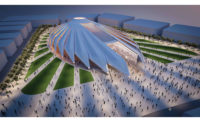Curtis Fentress had just three weeks to come up with a design for Denver International Airport. Completed in 1995, the airport—with its distinctive peaked white-fabric roof—helped put Fentress and his Denver-based firm in the architectural spotlight. Since then, the 64-year-old North Carolina native has built a reputation as a forward-thinking designer of airports and other civic buildings. His airports, including South Korea’s Incheon International, are consistently top-rated in passenger surveys. Currently under construction is a $1.4 billion expansion of Los Angeles International Airport, the first major addition to LAX since 1984. With two-story jetways, it will accommodate nine double-decker Airbus A380 airliners at one time. Fentress spoke to Architectural Record about this project and the changing nature of air travel. The firm’s airports are the focus of an exhibition at the Denver Art Museum. "Now Boarding: Fentress Airports + The Architecture of Flight" runs through Oct. 7, 2012.
DH: What makes a good airport?
CF: A terrific passenger experience. An airport should have a pleasant, streamlined flow for the passenger to get into the building and go through it with great ease. You shouldn’t have to stand in a lot of lines. The building should be elegant and filled with daylight, with lots of conveniences, whether it’s food or retail. Certainly you want dramatic and interesting spaces, and architecture that relates to the place.
DH: Air travel was once considered glamorous. Can good design help bring that back?
CF: I think it can help. In 1959, we had about 60 million passengers flying commercially in the United States. Today, one airport might have that many people flying through in a year. Air travel has gotten quite complex in terms of the number of people flying. But if you take the time with the design, you can make spaces that are open, airy, and pleasant, with opportunities to look outside and see the planes. We used to have observation areas at airports where you could do that. There are very few of those places anymore. Our expansion project at Seattle-Tacoma International Airport tries to bring that back. You can pull a rocking chair up to the glass and watch the planes.
DH: Airports are increasingly becoming “airport cities,” with office parks, hotels, housing developments, and shopping centers. How will that change the airport experience?
CF: Going to the airport and catching a plane is still the main objective, but we’re starting to see more hotels that are closer to airports. Dallas has one, and Houston has a couple. It’s convenient to have a hotel at the airport for meetings, or maybe to spend the night and catch your flight the next day, or if your flight is delayed and you need a place to stay. We are beginning to see this concept of the airport city, and as it catches on, I think you’ll see more growth at airports. I’m not sure we’ll see full-fledged shopping centers right away, but it’s a matter of time. We’re adding more retail to our projects, but there is a limit to how much one can carry. At some airports, though, like Singapore, you can get measured for a custom suit, and a few days after you’ve arrived at your destination, your new suit will arrive.
DH: Give us a preview of your addition to Los Angeles International Airport.
CF: It looks like a series of giant waves coming in on a beach. The centerpiece will be about 90,000 square feet of retail space, and 50,000 square feet of first-class and business-class lounges that overlook the space. The retail will be high-end tablecloth restaurants as well as fast food, and there will be duty-free shopping and all sorts of fine apparel and merchandise.
DH: What was the biggest design challenge?
CF: The biggest challenge has been the timetable. It’s all happened in about three years, which is very, very fast for an airport. That was one of the requirements, to do this as quickly as possible.
DH: You’ve urged architects to “restrain the ego,” and you’ve said, “A building is not the autobiography of an architect.” Why not?
CF: I guess if you’re Frank Lloyd Wright, that’s what architecture is about. But for me, architecture is more about the people who use the building. I think that’s an important thing, thinking about how people use the building and what they need and being more pragmatic about the design. I suppose we do impose a personality, because we believe that a building should be designed for a specific place and embody the spirit and culture of that place. But I don’t think a modernist design necessarily fits anywhere in the world. Architecture is not a one-size-fits-all kind of thing.








Post a comment to this article
Report Abusive Comment